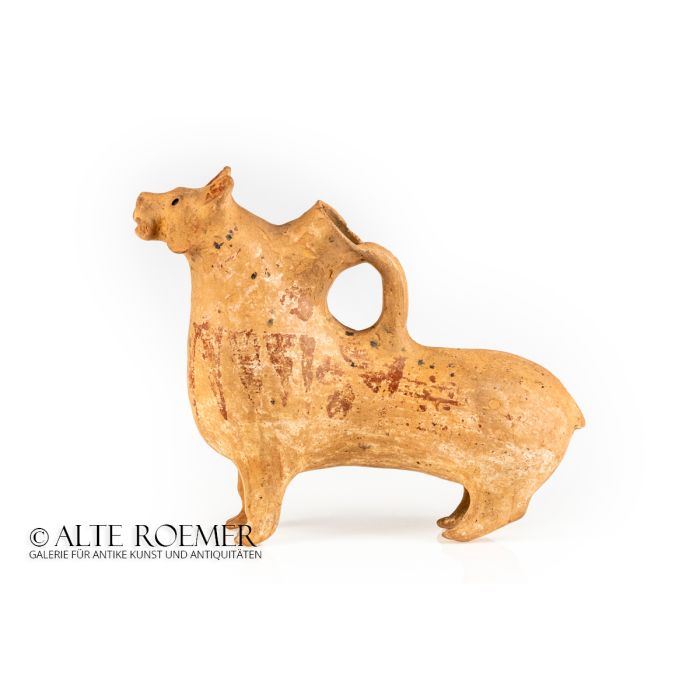Iron Age pottery vessel in the shape of a tiger
Price: on request
Sold
Object number
AR3118
| Object: |
Western Asiatic pottery vessel in the shape of a tiger
|
| Material: |
Pottery with remains of the original red-brown and black paint. The inserted eyes made of stone.
|
| Period: |
Early 1st cent. BC. Iron Age. A thermoluminescence analysis by Oxford University from 1981 dates the piece to the period between 1400 BC to 400 BC, confirming the attribution and period given by us above. |
| Description: |
Large pottery vessel in the shape of an animal that can be identified as a big cat. The elongated, waisted body is modelled with four feet, a relief tail, a strong neck and a characteristic head. It is probably a depiction of a tiger. On the back there is a vessel neck with a larger filling opening and a handle attached to it. A small hole in the mouth served as a spout. Remnants of the painting and inserted eyes reinforce the big cat's shape. The piece probably comes from modern-day Azerbaijan or northern Iran. It is a wonderful example of the art of a culture between the steppe life and sedentism. |
| Dimensions: |
28cm lengths, 23cm height, 8.5cm width.
|
| Condition: |
Very good condition for a vessel of this size. A few inconspicuous chips on the body, for example on the tail and at the neck of the vessel. The left front leg is broken and reattached. There are a few holes on the left front leg, probably from the older TL test, which at that time still required a lot of sample material. The eye inserts are still in place, as are parts of the original painting.
|
| Provenance: |
Acquired by us on the British art market in 2020. Previously in a British private collection, acquired from the British Mahboubian Gallery Collection. The above mentioned thermoluminescence report was commissioned by Houshang Mahboubian in 1981. The earlier history can be reconstructed with some probability. It can be assumed that the object was found during an excavation in Azerbaijan in the 1900s to 1930s. Dr. Benjamin Mahboubian (1868-1968), Houshang Mahboubian's father, participated in more than 100 excavations and made a significant impact shedding light on the history of Iran and its northern neighbour Azerbaijan. For example, a well-known excavation took place in Hasanlu in Azerbaijan. During his archaeological work, he acquired a substantial collection of artefacts that he exported from Iran in the 1930s. Also this object must have come into the Mahboubian family collection in this way. Houshang Mahboubian organized and examined his father's collection from the 1970s onwards and established the Mahboubian Gallery in London. |
| Authenticity: |
We unconditionally guarantee the authenticity of every artefact, all items are subject to our lifetime return policy on authenticity.
|


